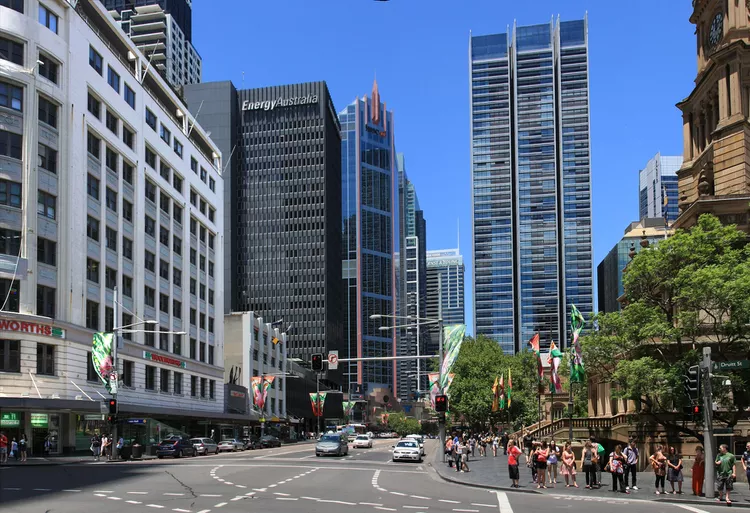1. Introduction
2. History of George Street
3. Central Station
4. Haymarket and Chinatown
5. Sydney Town Hall
6. Queen Victoria Building
7. Martin Place
8. Circular Quay
9. The Rocks
George Street in Sydney is the oldest street in Australia. It began as a track from Captain Arthur Phillip’s settlement at what is now The Rocks, leading southward towards the area of today’s Central train station. Furthermore, it became colonial Sydney’s main avenue, originally called High Street, adhering to the English naming customs of the time.
Today’s residents and visitors to Sydney might mistakenly believe George Street honors King George VI of England, the father of Queen Elizabeth II. However, it was actually named by New South Wales Governor Lachlan Macquarie in 1810 in tribute to George III (1738–1820), the reigning English monarch at the time. In parallel, Elizabeth Street was named for Governor Macquarie’s wife, Elizabeth Henrietta Macquarie (1778–1835), not for Queen Elizabeth II.
George Street stretches from its southern intersection with Harris Street, continuing as Broadway and eventually merging with Parramatta Road, which is part of the Great Western Highway. Heading towards the center of the city, it extends to Railway Square – named for its proximity to Sydney’s major public transport interchange, Central Station – and continues northward to The Rocks.
Central Station

At Central Station, or simply “Central,” travelers can board city trains to the suburbs as well as country trains serving New South Wales and beyond. Notably, this includes the long-distance transcontinental Indian Pacific to Perth, with connections at Adelaide on the Ghan to Darwin.
The light rail tram system in Sydney begins at Central, traversing through Chinatown, Darling Harbour, The Star gaming complex, and the Sydney Fish Markets before reaching the inner western suburbs, including Rozelle and Lilyfield.
Bus stops are strategically located in Central Square, along Eddy Avenue off Pitt Street, and on Chalmers Street on the eastern side of Central Station.
Haymarket and Chinatown

Just off George Street, west through Hay Street, visitors encounter Sydney’s Haymarket and Chinatown. The market area is well-known for its bargain shopping, while the restaurants on Dixon Street provide various culinary delights for those who enjoy Chinese cuisine.
If you stroll east on Campbell Street, you will find Sydney’s Capitol Theatre, famous for showcasing a range of musicals and performing arts.
Heading north along George Street, the Event Cinema complex offers an opportunity to catch the latest films.
Sydney Town Hall

Home to the local government of the City of Sydney, which encompasses the central business district and nearby suburbs, Sydney Town Hall serves multiple purposes. The structure is not only headquarters for the council but also a popular venue for concerts, exhibitions, and various community events. Its main steps facing George Street are a well-known gathering spot.
Queen Victoria Building

This architectural masterpiece, completed in 1898, was saved from potential demolition in the late 1950s after a comprehensive renovation restored its Romanesque design. The Queen Victoria Building commemorates the long-reigning English monarch, Queen Victoria (1819–1901), who ruled the United Kingdom from June 20, 1837.
Today, it houses an array of shops and dining options, conveniently accessible from the Town Hall train station and the surrounding area, along with local bus routes traveling along George Street.
Martin Place

Martin Place stands as one of Sydney’s most recognized pedestrian malls, nestled between George Street and Macquarie Street within the city’s bustling business district. The cenotaph honoring the Anzacs of World War I is a significant landmark and a traditional site for Anzac Day ceremonies. Martin Place also hosts various festivals and special events throughout the year.
Visitors will find easy access to nearby train stations, with Wynyard offering a George Street entrance and the eastern end of Martin Place connected as well. This area remains a popular meeting point for city workers and tourists, especially during lunch hours on weekdays.
Circular Quay

Located near the northern end of George Street, Circular Quay features ferry jetties, train stations, and bus stops, making it an excellent starting point for exploring notable sites such as the Sydney Opera House, Royal Botanic Gardens, The Rocks, and the Museum of Contemporary Art Australia.
Along the waterfront of Circular Quay, diners can find an array of fine restaurants, particularly while heading towards the Opera House to the east or the Overseas Passenger Terminal to the west.
The Rocks

The Rocks, recognized as the birthplace of modern Australia, offers an authentic end to your exploration of George Street as it concludes beneath the southern end of the Sydney Harbour Bridge.
This historic location marks the arrival of the First Fleet in 1788, led by Admiral Arthur Phillip (1738–1814), the first governor of New South Wales and pivotal figure in Sydney’s establishment. It is, therefore, the site where the story of George Street and the city first began.





